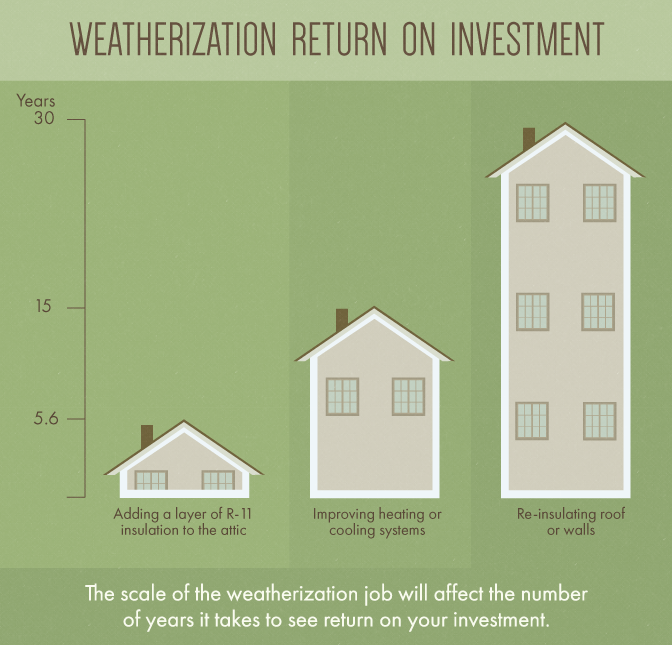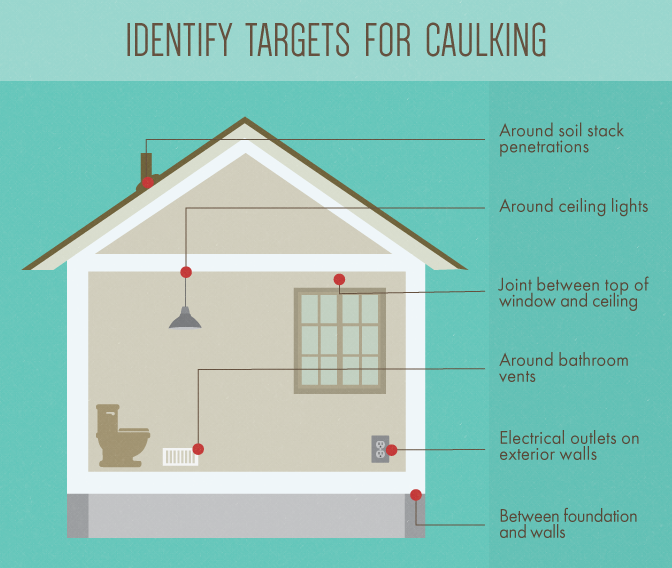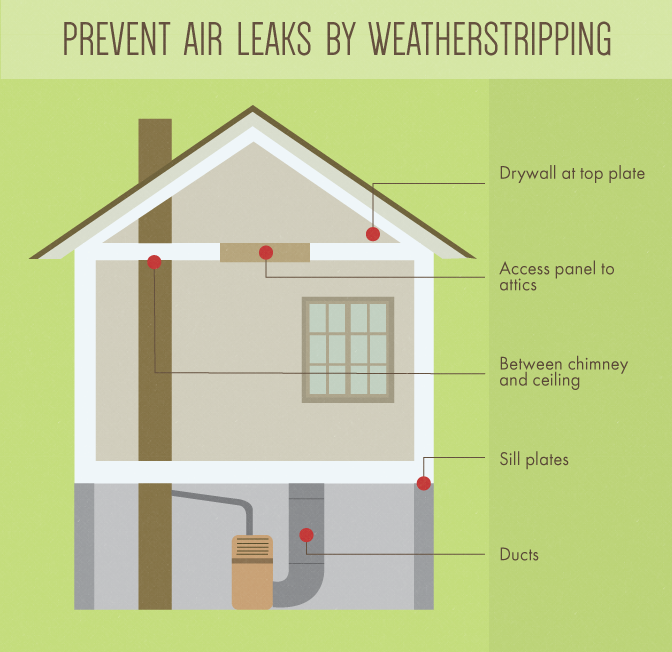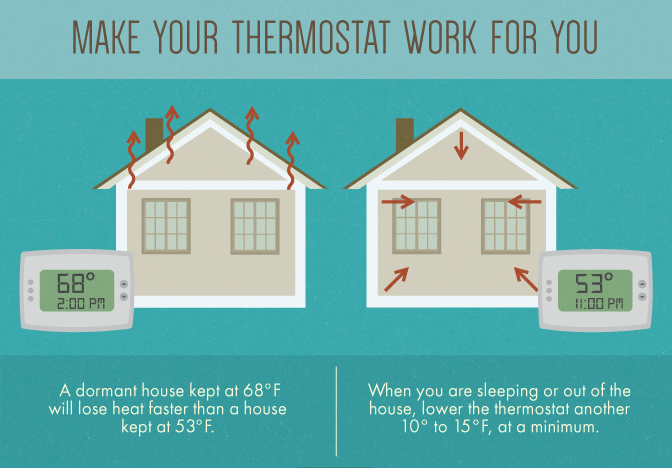Spend a Weekend Weatherizing Your House
You Will Reap the Benefits for Years
If you could tackle a few easy tasks that would keep you warm and snug all winter – and save money – would you? Strangely enough, few people opt to take on these tasks... Going under the collective term weatherization, these jobs range from squirting caulk with a gun (easy, yet effective) to more difficult jobs like rolling out attic insulation. Still, none of these projects are so tough that they involve tearing up floors or pulling down wallboard. It only takes a few moments to learn various weatherization practices that, despite their simplicity, are guaranteed to provide greater comfort and pare down your energy bill.
An Investment That Will Pay For Itself

In terms of comfort, you will immediately notice weatherization's benefits. Within minutes of weather-stripping a drafty window, you will be able to enjoy sitting next to that window with a book – without freezing.
Saving money is a different matter: it can take years to break even on some weatherization expenses. Be patient – eventually it is worth it. Weatherization is best viewed as a long-term investment, much like slowly contributing to a retirement fund or an interest-earning savings account. Some weatherizing projects, such as insulating the roof or walls, yield savings over the long haul, about 30 years (or the lifespan of the average mortgage). Although highly effective, these improvements have a high initial cost and thus take a longer time to pay off.1
To help with that initial investment, a vast array of federal, state, and local tax credits and rebates are available.2
Weatherization Methods That Do Not Work Well

Most weatherizing will be effective to a degree. Even a half-hearted squirt of caulk in the crack next to the door will produce some benefits, though minor. However, the claims of some manufacturers far outstrip the actual benefits.
Window Shrink Wrap Kits: You know the way hamburger at the grocery store comes shrink-wrapped in Styrofoam containers? Now, imagine the inside of your window shrink-wrapped. That is the concept behind window shrink wrap kits. You are supposed to attach clear, air-tight plastic film to the window frame, thus creating a “thermal barrier” to ward off drafts. It is a nice idea, except it does not work as well as claimed. Customers report that the film is nearly impossible to stretch tightly across the window. Once installed, the film continually threatens to fall off. Finally, the so-called thermal barrier is not much of a barrier, as the film is barely 0.75 thousandths of an inch thick.3
Storm Windows as Window Replacements: Storm windows are perfect for protecting your windows during inclement weather. They also provide a reasonable thermal barrier. But be careful of inflated claims of energy savings by window salesmen. Storm windows are not the same as replacing your windows, because the space created between the two windows is not a vacuum, nor is it filled with argon or krypton gas – the two most common ways that sealed, double-paned windows retard the escape of heat.4
Methods That Work
Unlike shrink wrap and storm windows, the following methods are good weatherization investments. Not only that, they are scalable, which means you can start with the easiest and work as far upward as you feel comfortable. Any stopping point will result in a net gain.
Caulking
Caulking is the classic weatherization tactic, and for good reason: it is cheap, anyone can do it, and it works. Use acrylic latex caulk that has added silicone. It costs a bit more, but should last for up to 10 years.
Identify air infiltration spots with a home energy audit or by wetting your hand in water and holding it near areas of suspected airflow.

Key places to caulk5:
- Joint between top of window and ceiling.
- Around soil stack penetrations.
- Around bathroom vents.
- Around ceiling lights.
Weatherstripping
Insert weatherstripping in cracks that are too wide for caulk. These long strips of foam or vinyl come in rolls and can be pushed into place by hand.
Important areas to weatherstrip6:
- Access panel to attic.
- Sill plates near house foundation.
- Around chimney (between chimney and ceiling).
Spray Foam
Expandable spray foam is available in 12-16 oz. cans, with attachable straws for squirting foam into small holes. Spray foam fills gaps larger than those that can be filled with caulk or weatherstripping.7
Insulated Curtains
Insulated, or thermal, curtains are heavily lined curtains that slow the exchange of heat between interior and exterior. These curtains are essentially a four-layer sandwich: a decorative outer layer, high-density foam, a vapor barrier, and a reflective layer to bounce heat back into the room.8
While you can make your own insulated curtains, you can also buy them ready-made from most major retailers that carry conventional curtains.
Seal the Chimney

Shutting the chimney damper is one way to close up the flue. But to limit the escape of heat effectively, you need better techniques:
- One quick-and-dirty method is to plug the hole with a temporary device, such as the Chimney Balloon. This item inflates to fill the hole, preventing warm air from flowing upward and outward.9
- A more attractive and permanent solution for new homes is to install a sealed, gasketed, glass fireplace. Not only is this a great idea, but the International Energy Conservation Code (IECC) now requires that all new wood-burning fireplaces implement these energy-saving devices.10
- For existing fireplaces, it is a snap to retrofit the firebox with glass doors. Running about $250-$300, these kits allow you to snap the frame and doors into the firebox without drilling into masonry.11
Programmable Thermostat

Given the fact that programmable thermostats can be purchased for less than $30 and can save you up to $180 per year, installing one is an unbeatable deal.12
As long as your current thermostat only has two wires, you can install a programmable, battery-powered thermostat with ease yourself. Three-wire thermostats are hard-wired to your home's electrical system and are best installed by qualified HVAC specialists.13
Attic Insulation
While never quick, installing fiberglass attic insulation is always bound to be dirty. Attic insulation is the ultimate weekend weatherization project.
Since your ceiling's drywall has a ridiculously low R-value of about 0.45, it does little to stop your expensive heat from wafting up and away. And because heat rises, it is more prudent to insulate the attic than the walls (thankfully, attics are easier to insulate).
While blown-in cellulose insulation is a job for professionals, you can roll out fiberglass insulation by yourself over the course of a weekend.
Weatherizing is a method of increasing the comfort of your home and saving money over the long term.14 Any investment of your time and money will reap some benefits, so choose a task or two and start weatherizing!
Written by Lee Wallender (courtesy of Fix.com)
Original post can be found here: http://www.fix.com/blog/weatherize-your-home-for-winter/.
Sources:
- http://energy.gov/eere/wipo/what-weatherization
- http://dsireusa.org
- http://www.amazon.com/3M-Indoor-Window-Insulator-5-Window/dp/B00002NCJI#productDetails
- http://www.nps.gov/tps/sustainability/energy-efficiency/weatherization/windows-doors.htm
- http://www.dulley.com/docs/f937.htm
- http://www.frugaljack.com/savings-project-how-to-weatherstrip-double-hung-or-sash-windows
- http://greatstuff.dow.com/where-to-use/basement
- http://home.howstuffworks.com/home-improvement/heating-and-cooling/insulated-curtains.htm
- http://www.chimneyballoon.us
- http://www.stollfireplace.com/general/gasketeddoors
- http://www.thisoldhouse.com/toh/how-to/step/0,,1154375,00.html
- http://energystar.supportportal.com/link/portal/23002/23018/Article/15561/
- http://www.thisoldhouse.com/toh/how-to/intro/0,,20339398,00.html
- http://energy.gov/energysaver/articles/estimating-payback-period-additional-insulation
Our Mission
NESEA advances sustainability practices in the built environment by cultivating a cross-disciplinary community where practitioners are encouraged to share, collaborate and learn.




Add comment